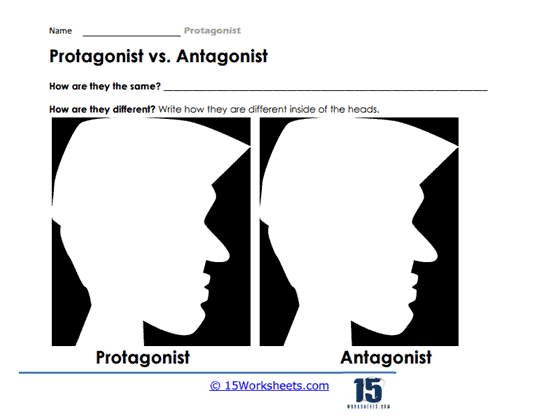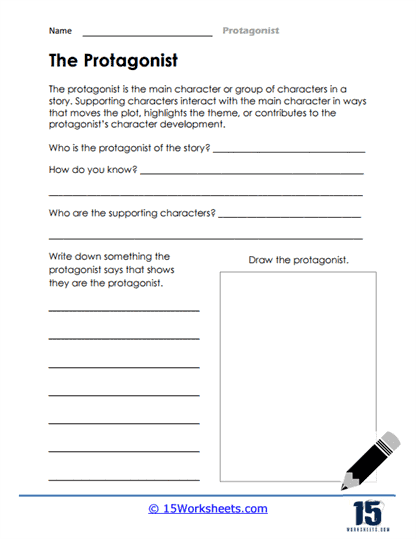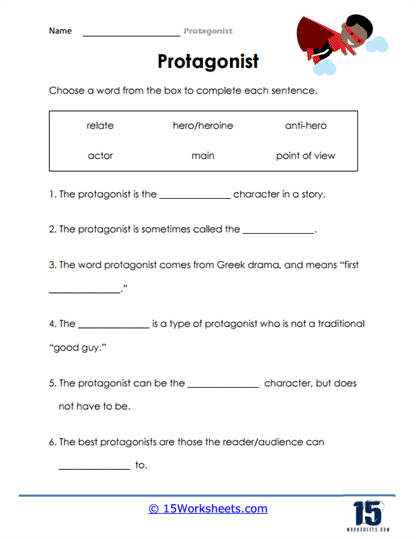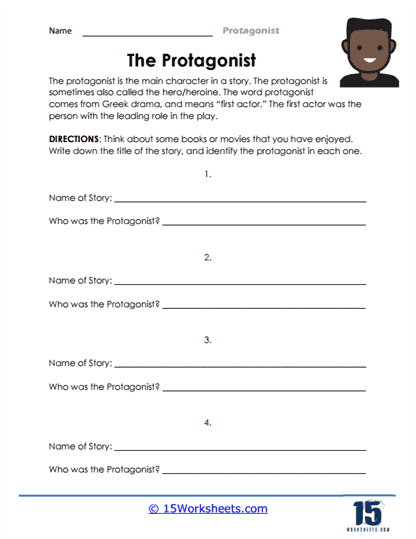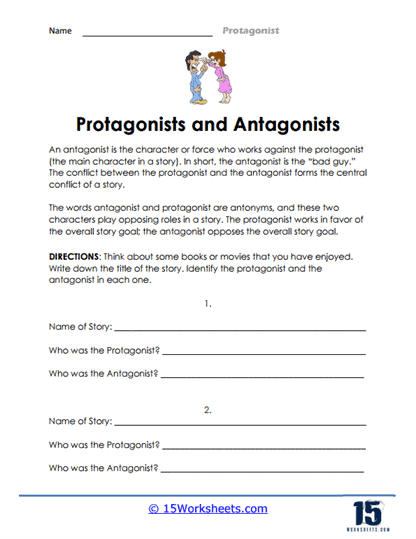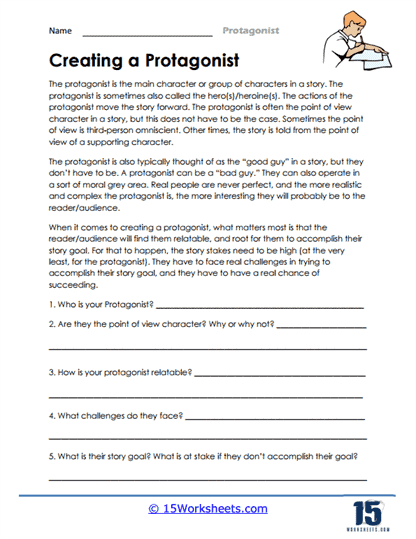Protagonist Worksheets
About These 15 Worksheets
Protagonist worksheets are educational tools designed to deepen students’ understanding of narrative structure, character development, and thematic exploration in literature and storytelling. These worksheets focus on the protagonist, the central character around whom the story revolves, and guide students through a series of exercises aimed at analyzing and understanding the protagonist’s role, motivations, growth, and impact on the story’s outcome. By engaging with these worksheets, students enhance their critical thinking, reading comprehension, and analytical writing skills, crucial components of language arts education.
Through a variety of exercises, these worksheets not only improve students’ language arts and reading skills but also equip them with critical thinking, empathy, and analytical writing abilities. Engaging with these tools allows students to delve deeper into texts, fostering a richer appreciation and understanding of literature.
The exercises found on protagonist worksheets can vary widely, each tailored to explore different aspects of the protagonist’s character and their narrative journey. Below are descriptions of common types of exercises you might encounter:
Character Traits Identification – This exercise involves listing the protagonist’s key traits, both physical and personality-based. Students may be asked to provide examples from the text that illustrate these traits, fostering close reading and textual evidence gathering.
Conflict Analysis – Here, students examine the central conflicts involving the protagonist, distinguishing between internal and external conflicts. They analyze how these conflicts drive the narrative forward and influence the protagonist’s development.
Motivation Exploration – Students delve into the protagonist’s motivations, exploring what drives their actions, decisions, and changes throughout the story. This exercise helps students understand characters’ complexities and the reasons behind their journey.
Change Over Time – This type of exercise asks students to chart the protagonist’s development from the beginning to the end of the story. It focuses on character growth or regression, highlighting how events and interactions with other characters influence the protagonist.
Relationship Maps – Students create diagrams or maps illustrating the protagonist’s relationships with other characters, noting the nature of these relationships (friendly, antagonistic, familial) and their evolution over the course of the story. This exercise enhances understanding of character dynamics and their impact on the protagonist.
Point of View Analysis – Although not exclusively focused on the protagonist, this exercise involves examining the story’s point of view (first person, third person limited, omniscient) and its effect on how the protagonist is portrayed and understood by the reader.
Quote Analysis – Students select key quotes by or about the protagonist and analyze their significance. This exercise encourages close reading and interpretation of how the protagonist’s words or others’ perceptions of them deepen the reader’s understanding of the character.
Impact on Plot – Here, students assess how the protagonist’s actions drive the plot forward, identifying key decisions or actions that led to major plot developments. This exercise links character analysis with plot structure understanding.
Creative Perspective-Taking – Students may be asked to write short pieces from the protagonist’s perspective or letters between the protagonist and other characters. This creative exercise fosters empathy and a deeper understanding of the protagonist’s internal world.
The Benefits of These Worksheets
Practicing with protagonist worksheets can significantly improve students’ understanding of language arts and reading skills in several ways:
Enhanced Comprehension – By focusing on the protagonist, students gain a nuanced understanding of the narrative, including plot dynamics, character motivations, and thematic elements. This deep dive into the story’s core helps improve overall reading comprehension.
Critical Thinking – Analyzing a protagonist’s traits, motivations, and development requires critical thinking. Students must evaluate textual evidence, make inferences, and draw conclusions, strengthening these essential analytical skills.
Writing Skills – Many exercises on protagonist worksheets involve writing, whether it’s summarizing traits, analyzing quotes, or creating creative perspectives. These activities hone writing skills, particularly in analytical and creative contexts.
Empathy and Perspective-Taking – Understanding a protagonist’s motivations, conflicts, and growth fosters empathy and the ability to view situations from multiple perspectives. These are valuable skills not only in language arts but in students’ personal and social lives.
Connection to Themes – By connecting the protagonist’s journey to broader themes, students appreciate the depth and relevance of literature to human experience and societal issues. This deepens their engagement with texts and enhances thematic understanding.
What is the Literary Device of Protagonist?
The literary device of the protagonist plays a crucial role in narrative and storytelling, serving as the central figure around whom the plot revolves. A protagonist is not merely a character but a pivotal element that authors use to navigate through the narrative, explore themes, and connect with the audience. This device is fundamental in both classical and contemporary literature, shaping the way stories are told and received.
The Defining Feature of a Protagonist
The main defining feature of a protagonist is their central role in the narrative. They are the primary character who faces the conflict head-on, making decisions that propel the story forward. Unlike other characters who may play significant roles, the protagonist’s journey is the story’s backbone, guiding the plot’s direction and engaging the reader’s interest and emotions.
Central to the Plot – The protagonist’s actions and decisions are pivotal to the narrative’s development. The plot often unfolds based on their responses to challenges or conflicts.
Undergoes Change – A key characteristic is the protagonist’s development or transformation throughout the story. This change is often a result of overcoming obstacles or personal growth.
Relatable – Authors typically craft protagonists with relatable traits or flaws, making it easier for readers to empathize with them. This relatability strengthens the reader’s investment in the character’s journey.
Faces Conflict – The protagonist is directly involved in the story’s central conflict. This conflict can be internal, external, or both, driving the narrative tension and character development.
Evokes Reader’s Emotion – Through their struggles, victories, and failures, protagonists are designed to evoke emotions such as empathy, admiration, or even frustration from the reader.
Reflects Theme – Often, the protagonist’s journey reflects the broader themes of the story, allowing the author to explore complex ideas or moral questions through the character’s experiences.
Examples of Protagonists in Literature
Elizabeth Bennet in “Pride and Prejudice” by Jane Austen – Elizabeth stands as a remarkable protagonist, embodying the themes of personal growth and social critique. Her witty and spirited nature challenges societal norms of early 19th-century England. Elizabeth’s evolution, marked by her overcoming of personal prejudices and misjudgments, particularly in her relationship with Mr. Darcy, underscores the novel’s exploration of pride, prejudice, and the complexities of human interaction. Austen uses Elizabeth’s perspective to critique class and gender expectations, making her a compelling and relatable figure whose journey towards understanding and love captivates readers.
Harry Potter in “Harry Potter” series by J.K. Rowling – Harry Potter serves as the quintessential protagonist in the realm of fantasy literature. Orphaned as a baby and marked by a unique connection to the dark wizard Voldemort, Harry’s journey is one of self-discovery, bravery, and sacrifice. Throughout the series, Harry navigates the challenges of adolescence while confronting the evils that threaten the wizarding world. His character embodies themes of friendship, courage, and the fight against oppression. Rowling crafts Harry’s experiences to engage readers’ emotions, inspiring a deep connection to his battles and triumphs.
Jay Gatsby in “The Great Gatsby” by F. Scott Fitzgerald – Jay Gatsby, the enigmatic millionaire with a mysterious past, is a protagonist who embodies the American Dream’s illusions and the pursuit of unattainable desires. His obsession with recapturing the past and his love for Daisy Buchanan drive the novel’s plot and thematic concerns. Gatsby’s tragic journey, marked by ambition, love, and disillusionment, critiques the decadence of the Jazz Age and the hollowness of the American Dream. Fitzgerald uses Gatsby to explore themes of identity, aspiration, and the inevitable disillusionment that comes with chasing after fantasies.
The Effect of the Protagonist on the Reader
The protagonist significantly influences the reader’s engagement with the story. Through the protagonist’s eyes, readers experience the narrative, making the protagonist’s relatability and journey crucial for sustaining interest and emotional investment. The protagonist acts as the reader’s guide, making the narrative’s events and themes more accessible and impactful. By identifying with the protagonist, readers can explore complex emotions, moral dilemmas, and human experiences, enriching their understanding of the narrative and its underlying messages.
A well-crafted protagonist can inspire readers, provoke thought, and evoke a range of emotions, from empathy to frustration. This emotional connection is essential for the story’s impact, making the protagonist a powerful tool for authors to convey themes, critique social norms, and explore the human condition. Ultimately, the protagonist’s journey offers readers a mirror to reflect on their own experiences and the world around them, underscoring the profound effect literature can have on its audience.



